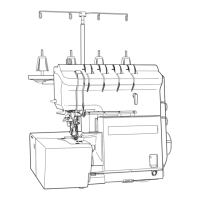–
75
–
6
TROUBLES AND CORRECTIVE MEASURES
Trouble Case (1) Case (2) Check and Corrective measures
1. Needle thread breakage 1-1) Threading 1-A) The thread is entangled with the thread
guide, or the machine head has been incor-
rectly threaded.
Refer to the threading diagram.
(Refer to the Instruction Manual)
1-2) Thread path 2-A) Scratches, burrs or rust on the pawls or
needle holes of the throat plate, stitch
tongue, lower looper, needle thread take-up,
needle thread presser spring, thread guide,
or tension discs causes friction.
Remove such scratches, burrs, etc. and
perform thread path nishing. Replace major
components such as looper, which have been
deformed, causing thread breakage.
2-B) Bend or deformation of the thread path. Correct the thread path or replace it with a new
one.
1-3) Needle guard 3-A) The needle hits the needle guard intense-
ly,and sharp edges are produced on them,-
causing thread breakage.
Replace the needle and needle guard if they
have worn.
1-4) Needle 4-A) The needle is too thin for the thread. Replace the needle by a proper one.
1-5) Thread 5-A) The thread is weak because of its poor
quality.
Replace the thread by one with good quality.
1-6) Thread tension 6-A) The thread tension is too high. Reduce the thread tension. Check whether the
needle thread take-up guide and needle thread
guide are positioned too high, causing such
excessive thread tension.
6-B) The thread tension controller is poorly ad-
justed.
Adjust the thread tension controller so that the
standard thread tension is obtained.
1-7) Contact 7-A) The lower looper has been improperly po-
sitioned and strikes the feed dog or throat
plate.
Properly position the lower looper.
WARNING :
To protect against possible personal injury due to abrupt start of the machine, be sure to start the following work
after turning the power o and ascertaining that the motor is at rest.

